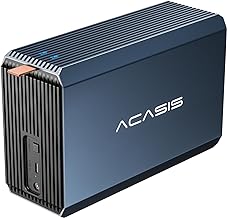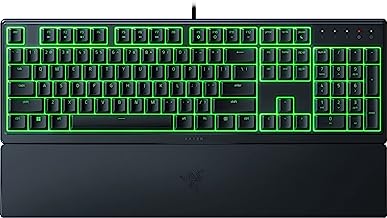5 important factors worth considering when looking for the best external raid enclosures
When looking at external RAID enclosures, there are many important factors to think about before choosing the one that best fits your needs. These storage solutions are important for managing and protecting data, so it’s essential to carefully consider all your options. From how it connects to your computer to how much storage it can hold, each aspect plays a big role in how well the enclosure will work for you. By focusing on these key details and understanding what each one means, you can make sure you get the most out of your external RAID enclosure and improve your storage capabilities.
See our guide to the best external raid enclosures.
Drive capacity and compatibility
When you’re shopping for external RAID enclosures, it’s important to look at the drive capacity and compatibility. Many people get excited about having a lot of storage space and choose the biggest drives they can find. But using drives that don’t work well together can cause problems with how the RAID system runs. To make sure everything works smoothly and your data stays safe, it’s best to pick drives that have similar specs. This way, you can take full advantage of the RAID system without running into compatibility issues.
Not thinking about drive compatibility can also make it harder to upgrade or add more storage later on. If your current setup can’t support larger or different drives, expanding your storage space can be a headache. To make things easier in the long run, it’s smart to choose drives that will work with your current setup and still be useful for future upgrades. By planning ahead and picking drives that can grow with your system, you can make sure your RAID setup keeps up with changes in storage technology without needing major changes or replacements. In the world of data storage, getting the right balance between drive capacity and compatibility is key for a system that can adapt and expand along with your storage needs.
RAID level support
When you’re looking to invest in an external RAID enclosure, it’s important to consider the support for different RAID levels. Choosing an enclosure that offers a variety of RAID levels gives you the ability to customize your storage setup based on your specific needs.
RAID 0 focuses on maximizing performance and storage capacity through striping, while RAID 1 prioritizes data redundancy by mirroring. Including RAID 5 and RAID 10 adds a balance of performance, redundancy, and efficiency to the mix.
Having support for multiple RAID levels demonstrates a proactive approach to future-proofing your storage solution, ensuring it can adapt as your needs change over time.
Exploring the options for RAID level support in external enclosures opens up a world of possibilities, allowing users to adjust their storage setup to meet their individual requirements. RAID 6 is a strong choice for protecting against dual disk failures, offering resilience in challenging situations. RAID 50 and RAID 60 cater to environments that need both performance and fault tolerance by blending different approaches.
By incorporating a range of RAID levels, external RAID enclosures not only address current needs but also set the stage for future growth and optimization. The key is to choose an enclosure that supports a variety of RAID levels, empowering users to make the most of their storage system with confidence.
Connectivity options
When you’re looking to invest in an external RAID enclosure, the type of connection you choose is really important for getting the best performance and features. While many people like using USB because it works with lots of devices, if you want faster speeds and smoother data transfer, you should think about using Thunderbolt instead. Thunderbolt is a great choice for professionals who work with big files and do a lot of heavy-duty tasks because it’s super fast and lets you connect multiple devices easily. Just remember that Thunderbolt might cost more than USB, so you’ll need to think about whether the extra speed is worth the higher price.
It’s always important to keep up with new technology, so make sure to explore options like USB 4 and Thunderbolt 4 to make sure your external RAID system stays current. These newer standards offer better speeds and features that can make your work easier and more efficient. By using the latest connection options, you can be sure your data transfer is smooth, your system works well, and you have all the tools you need now and in the future. Ultimately, the connection you pick for your external RAID system should fit your needs, your budget, and the type of work you do so you can make the most of your storage setup.
Cooling and noise levels
When looking at external RAID enclosures, it’s important to consider how cooling and noise levels impact performance and usability. Good cooling systems help protect hard drives and make data transfers smooth. They also keep performance stable and reliable over time. On the other hand, poor cooling can cause overheating, which can damage data and shorten drive lifespan. Noise levels in enclosures can also affect user experience. Too much noise can be disruptive, especially in quiet settings or offices where concentration is important. Choosing enclosures with noise-reducing features can improve the user experience and create a better work environment.
When choosing external RAID enclosures, it’s crucial to find a balance between cooling and noise levels that suit your needs. Look for enclosures with advanced cooling technology, like efficient fans or quiet designs, to protect your data and keep performance high. Choosing enclosures with noise-reducing features can make working near them more comfortable and productive. By considering these factors, you can ensure a smooth and efficient experience with your external RAID enclosures for storing and backing up data.
Build quality and durability
When you’re looking to buy an external RAID enclosure, it’s important to consider how well it’s built and how long it will last. These qualities are key to ensuring that your data stays safe and accessible over time. A strong enclosure not only protects your hard drives but also reduces the risk of damage and data loss. Choosing products made from high-quality materials like aluminum or strong plastic can help protect your data from accidents and the environment. Durability is also important, as it ensures consistent performance even with heavy use, showing that the manufacturer is committed to creating long-lasting products.
Having a sturdy and durable external RAID enclosure is like having a fortress for your data, giving you peace of mind and protection in the ever-changing digital world.
The combination of good build quality and durability shows that a manufacturer cares about customer satisfaction and product quality. It shows a commitment to craftsmanship beyond just functionality, focusing on design and engineering as a whole. A high-quality external RAID enclosure brings together both looks and performance, creating a seamless experience for users. By choosing a well-built and durable enclosure, you not only keep your data safe but also support a brand that values precision and reliability. Overall, the blend of top-notch build quality and long-lasting durability in an external RAID enclosure shows innovation and strength, helping users navigate the digital world with confidence.
Conclusion
In the ever-changing world of technology, external RAID enclosures are a flexible storage solution that provides good performance, reliability, and flexibility. As technology expands, it is essential to protect data efficiently and securely. Using external RAID enclosures can help people and companies better manage their data while keeping it safe and accessible. Overall, the versatility of external RAID enclosures demonstrates their importance in meeting the needs of modern data storage.


